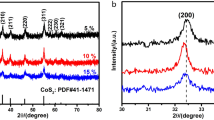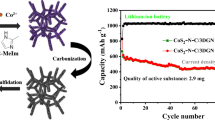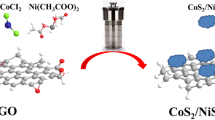Abstract
Metal sulfides (MSs) exhibit great prospects as high-performance electrodes for sodium-ion batteries (SIBs), because of the excellent redox reversibility and relatively high theoretical capacity of the conversion-type electrochemical reaction. However, they suffer from intrinsic poor electrical conductivity and tremendous volume expansion during the Na+ insertion process, which would lead to sluggish reaction kinetic and severe capacity damping. Generally, designing hybrid structures with a secure framework, which could withstand the tension brought by the volume change, is an effective way to promote cycling stability. Besides, the carbonaceous material is considered to be an important additive, which can effectively elevate the electron/ion conductivity and realize the high-rate performance of the anode. Herein, a comprehensive 0-dimensional/2-dimensional (0D/2D) structure of carbon-coated CoS2 nanospheres encapsulated in reduced graphene oxide (denoted as CoS2@C/RG) is designed as anode material for SIBs. In the notable 0D/2D CoS2@C/RG structure, the nanoscale CoS2@C particles and RG nanosheets provide a high superficial area for Na+ insertion and shortened Na+ diffusion pathway. Furthermore, benefiting from the high conductivity and structural flexibility, the introduced RG supplies fast electron transportation channel and guarantees structural stability of the anode, which brings in improved reaction kinetic and structural stability. Consequently, the CoS2@C/RG electrode delivers a high specific capacity of 716.3 mAh/g at 0.2 A/g after 100 cycles, excellent rate performance, and stable cyclicity of 514.9 mAh/g at 5 A/g after 600 cycles. This work broadens the scope of rationally constructing comprehensive structures and may shed new light on MSs-based multidimensional anode material for SIBs.




Similar content being viewed by others
Availability of data and materials
The authors confirm that all the data generated during the findings of this study are available within the article and its supplementary materials.
References
Zhang W, Li M, Chen Y et al (2023) Facile synthesis of honeycomb-structured biochar with high specific surface and its electrochemical properties as anodes for Na-ion batteries. Ionics. https://doi.org/10.1007/s11581-023-05235-0
J Ding H Chen X Lou et al (2023) Preparations of PTCDI derivatives with high capacity and long life and their applications for aqueous ammonium-ion batteries ionicshttps://doi.org/10.1007/s11581-023-05231-4
Lu Z, Zhai Y, Wang N et al (2020) FeS2 nanoparticles embedded in N/S co-doped porous carbon fibers as anode for sodium-ion batteries. Chem Eng J 380(15):122455
Lu Z, Zhao Z, Liu G et al (2022) Bimetallic sulfide FeS2@SnS2 as high-performance anodes for sodium-ion batteries. Front Mater Sci 16(1):220593
Nayak PK, Yang L, Brehm W et al (2018) From lithium-ion to sodium-ion batteries: advantages, challenges, and surprises. Angew Chem Int Ed 57(1):102–120
Bai ZC, Zhang YH, Zhang YW et al (2015) MOFs-derived porous Mn2O3 as high-performance anode material for Li-ion battery. J Mater Chem A 3(10):5266–5269
Wen Y, He K, Zhu Y et al (2014) Expanded graphite as superior anode for sodium-ion batteries. Nat Commun 5:4033
Sun N, Guan Z, Liu Y et al (2019) Extended “adsorption-insertion” model: a new insight into the sodium storage mechanism of hard carbons. Adv Energy Mater 9(32):1901351
Xiao Y, Su D, Wang X et al (2018) CuS microspheres with tunable interlayer space and micropore as a high-rate and long-life anode for sodium-ion batteries. Adv Energy Mater 8(22):1800930
He X, Bi L, Li Y et al (2020) CoS2 embedded graphitic structured N-doped carbon spheres interlinked by rGO as anode materials for high-performance sodium-ion batteries. Electrochim Acta 332(1):135453
Sun R, Liu S, Wei Q et al (2017) Mesoporous NiS2 nanospheres anode with pseudocapacitance for high-rate and long-life sodium-ion battery. Small 13(39):1701744
Dong S, Li C, Ge X et al (2017) ZnS-Sb2S3@C core-double shell polyhedron structure derived from metal-organic framework as anodes for high performance sodium ion batteries. ACS Nano 11(6):6474–6482
Zhang K, Park M, Zhou L et al (2016) Cobalt-doped FeS2 nanospheres with complete solid solubility as a high-performance anode material for sodium-ion batteries. Angew Chem Int Ed 55(41):12822–12826
Yang H, Wang M, Liu X et al (2018) MoS2 embedded in 3D interconnected carbon nanofiber film as a free-standing anode for sodium-ion batteries. Nano Res 11(7):3844–3853
Li S, Zhao Z, Liu Z et al (2019) (2019) SnS2@C hollow nanospheres with robust structural stability as high-performance anodes for sodium ion batteries. Nano Micro Lett 11(1):1–9
Li Z, Feng W, Lin Y et al (2016) Flaky CoS2 and graphene nanocomposite anode materials for sodium-ion batteries with improved performance. RSC Adv 6(74):70632–70637
Liu Q, Hu Z, Liang Y et al (2019) Facile synthesis of hierarchical hollow CoP@C composites with superior performance for sodium and potassium storage. Angew Chem Int Ed 59(13):5159–5164
Zhao B, Song D, Ding Y et al (2020) Size-tunable SnS2 nanoparticles assembled on graphene as anodes for high performance lithium/sodium-ion batteries. Electrochim Acta 354(1):136730
Zhao B, Liu Q, Wei G et al (2019) Synthesis of CoSe2 nanoparticles embedded in N-doped carbon with conformal TiO2 shell for sodium-ion batteries. Chem Eng J 378(15):122206
Yang SH, Park S-K, Kang YC (2019) Mesoporous CoSe2 nanoclusters threaded with nitrogen-doped carbon nanotubes for high-performance sodium-ion battery anodes. Chem Eng J 370(15):1008–1018
Sun J, Lee HW, Pasta M et al (2015) A phosphorene-graphene hybrid material as a high-capacity anode for sodium-ion batteries. Nat Nanotechnol 10(11):980–985
Liu X, Hao Y, Shu J et al (2019) Nitrogen/sulfur dual-doping of reduced graphene oxide harvesting hollow ZnSnS3 nano-microcubes with superior sodium storage. Nano Energy 57:414–423
Xia H, Li K, Guo Y et al (2018) CoS2 nanodots trapped within graphitic structured N-doped carbon spheres with efficient performances for lithium storage. J Mater Chem A 6(16):7148–7154
Wang S, Xiong P, Guo X et al (2020) A stable conversion and alloying anode for potassium-ion batteries: a combined strategy of encapsulation and confinement. Adv Funct Mater 30(27):2001588
Ma Y, Bresser D, Ji Y et al (2018) Cobalt disulfide nanoparticles embedded in porous carbonaceous micropoly-hedrons interlinked by carbon nanotubes for superior lithium and sodium storage. ACS Nano 12(7):7220–7231
Zhao Y, Fu Q, Wang D et al (2019) Co9S8@carbon yolk-shell nanocages as a high-performance direct conversion anode material for sodium ion batteries. Energy storage mater 18:51–58
Shi NX, Chu YT, Xi BJ et al (2020) Sandwich structures constructed by ZnSe⊂N-C@MoSe2 located in graphene for efficient sodium storage. Adv Energy Mater 10(41):2002298
Lu Z, Wang N, Zhang Y et al (2018) Pyrite FeS2@C nanorods as smart cathode for sodium ion battery with ultra-long lifespan and notable rate performance from tunable pseudocapacitance. Electrochim Acta 260(10):755–761
Lu Z, Wang W, Zhou J et al (2020) FeS2@C nanorods embedded in three-dimensional graphene as high-performance anode for sodium-ion batteries. Front Mater Sci 14(3):255–265
Xia J, Liu L, Xie J et al (2018) Free-standing SnS/C nanofiber anodes for ultralong cycle-life lithium-ion batteries and sodium-ion batteries. Energy Storage Mater 17:1–11
Ren X, Wang J, Zhu D et al (2018) Sn-C bonding riveted SnSe nanoplates vertically grown on nitrogen-doped carbon nanobelts for high-performance sodium-ion battery anodes. Nano Energy 54:322–330
Huang K, Xing Z, Wang L et al (2018) Direct synthesis of 3D hierarchically porous carbon/Sn composites via in situ generated NaCl crystals as templates for potassium-ion batteries anode. J Mater Chem A 6(2):434–442
Ramireddy T, Rahman M, Xing T et al (2014) Stable anode performance of an Sb–carbon nanocomposite in lithium-ion batteries and the effect of ball milling mode in the course of its preparation. J Mater Chem A 2(12):4282–4291
Zhang W, Yue Z, Wang Q et al (2020) Carbon-encapsulated CoS2 nanoparticles anchored on N-doped carbon nanofibers derived from ZIF-8/ZIF-67 as anode for sodium-ion batteries. Chem Eng J 380(15):122548
Xiao F, Yang X, Wang H et al (2020) Hierarchical CoS2/N-doped carbon@MoS2 nanosheets with enhanced sodium storage performance. ACS Appl Mater Interfaces 12(49):54644–54652
Xiao Y, Hwang J-Y, Belharouak I et al (2017) Superior Li/Na-storage capability of a carbon-free hierarchical CoSx hollow nanostructure. Nano Energy 32:320–328
Fang Y, Luan D, Chen Y et al (2020) Synthesis of copper-substituted CoS2@CuxS double-shelled nanoboxes by sequential ion exchange for efficient sodium storage. Angew Chem Int Ed 59(7):2644–2648
Zhang Z, Huang Y, Gao X et al (2020) Rational design of hierarchically structured CoS2@NCNTs from metal-organic frameworks for efficient lithium/sodium storage performance. ACS Appl Energy Mater 3(7):6205–6214
Yang J, Gao H, Men S et al (2018) CoSe2 Nanoparticles encapsulated by N-doped carbon framework intertwined with carbon nanotubes: high-performance dual-role anode materials for both Li- and Na-ion batteries. Adv Sci 5(12):1800763
Jian Z, Xing Z, Bommier C et al (2016) Hard carbon microspheres: potassium-ion anode versus sodium-ion anode. Adv Energy Mater 6(3):1501874
Yang T, Qian T, Wang M et al (2016) A sustainable route from biomass byproduct okara to high content nitrogen-doped carbon sheets for efficient sodium ion batteries. Adv Mater 28(3):539–545
Lu Z, Wang N, Zhang Y et al (2018) Metal-organic framework-derived sea-cucumber-like FeS2@C nanorods with out-standing pseudocapacitive Na-ion storage properties. ACS Appl Energy Mater 1(11):6234–6241
Xu Y, Liu X, Su H et al (2022) Hierarchical bimetallic selenides CoSe2–MoSe2/rGO for sodium/potassium-ion batteries anode: insights into the intercalation and conversion mechanism. Energy Environ Mater 5(2):627–636
Zhao Y, Wang J, Ma C (2019) Interconnected graphene nanosheets with confined FeS2/FeS binary nanoparticles as anode material of sodium-ion batteries. Chem Eng J 378(1):122168
Xu Y, Sun X, Li Z et al (2021) Boosting the K+ -adsorption capacity in edge-nitrogen doped hierarchically porous carbon spheres for ultrastable potassium ion battery anodes. Nanoscale 13:19634–19641
Li Z, Yang Y, Ding G et al (2022) Optimizing the nitrogen configuration in interlayer-expanded carbon materials via sulfur bridged bonds toward remarkable energy storage performances. J Mater Chem A 10:10033–10042
Zheng F, Chu K, Yang Y et al (2022) Optimizing the interlayer spacing of heteroatom-doped carbon nanofibers toward ultrahigh potassium-storage performances. ACS Appl Mater Interfaces 14:9212–9221
Niu P, Yang Y, Li Z et al (2022) Rational design of a hollow porous structure for enhancing diffusion kinetics of K ions in edge-nitrogen doped carbon nanorods. Nano Res 15(9):8109–8117
Funding
This work was supported by Nanyang Normal University (2022ZX007).
Author information
Authors and Affiliations
Corresponding author
Ethics declarations
Ethics approval and consent to participate
All analyses were based on previously published studies; thus, no ethical approval and patient consent are required.
Competing interests
The authors declare no competing interests.
Additional information
Publisher's Note
Springer Nature remains neutral with regard to jurisdictional claims in published maps and institutional affiliations.
Supplementary Information
Below is the link to the electronic supplementary material.
Rights and permissions
Springer Nature or its licensor (e.g. a society or other partner) holds exclusive rights to this article under a publishing agreement with the author(s) or other rightsholder(s); author self-archiving of the accepted manuscript version of this article is solely governed by the terms of such publishing agreement and applicable law.
About this article
Cite this article
Lu, Z., Li, J. CoS2@C nanospheres encapsulated in N-doped graphene oxide as high-performance anode for sodium-ion battery. Ionics 30, 2119–2126 (2024). https://doi.org/10.1007/s11581-024-05429-0
Received:
Revised:
Accepted:
Published:
Issue Date:
DOI: https://doi.org/10.1007/s11581-024-05429-0




